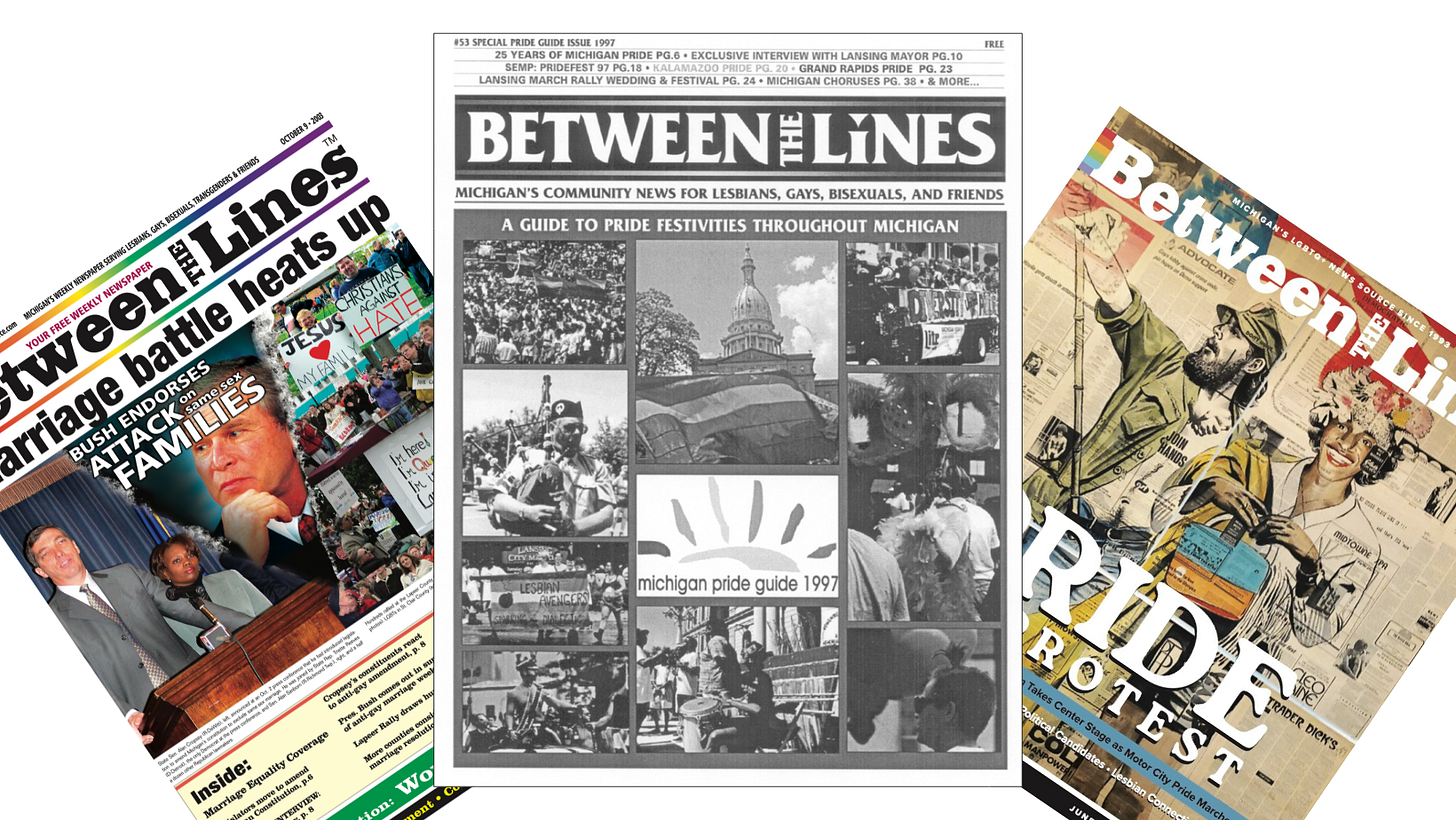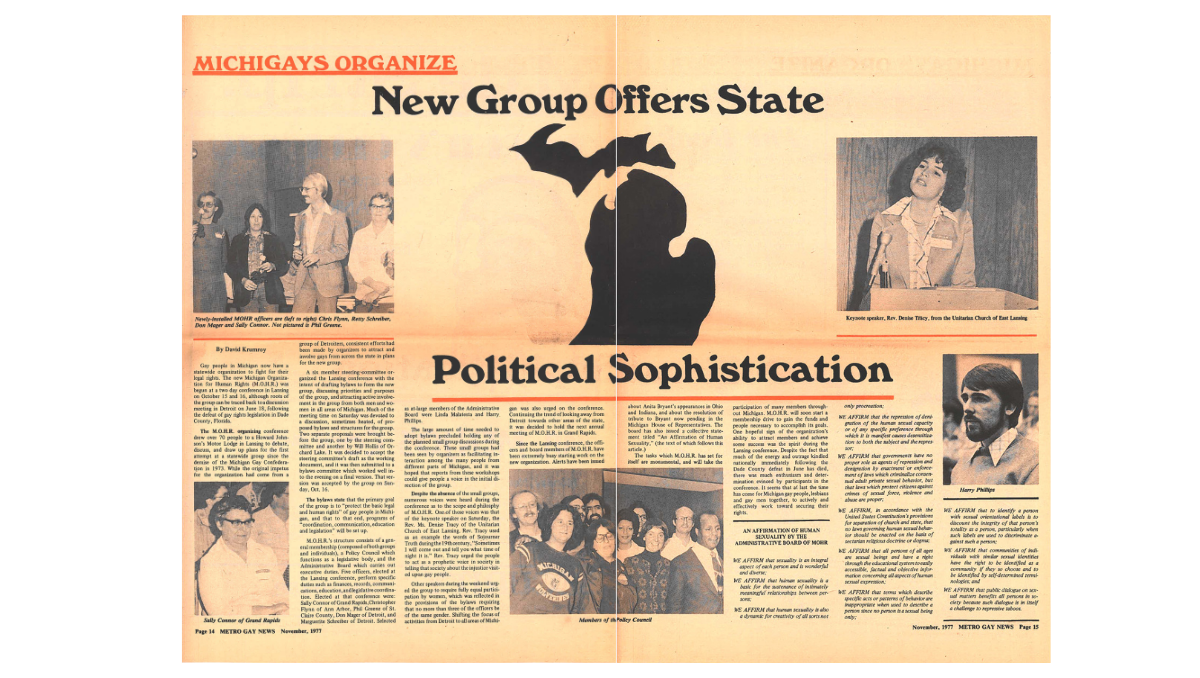Throwback Thursday: How Pride Source Carries Forward Michigan's Rich Queer Press History
From radical liberation journals to mainstream coverage, Michigan’s LGBTQ+ publications have served as lifelines for decades
By Hank Kennedy
Long before Between The Lines became Michigan's leading LGBTQ+ publication, Metro Detroit had a rich tradition of queer journalism spanning more than five decades. From revolutionary post-Stonewall newspapers to community magazines that weathered the AIDS crisis, Michigan's LGBTQ+ press has evolved from radical underground publications to mainstream advocacy journalism.
These publications have served as lifelines for readers who thought they were alone in the world, provided critical coverage during health crises and informed the public about ongoing battles for civil rights. Through periods of growth, decline and reinvention, Michigan's queer press has remained a vital voice for the community.
From revolution to mainstream
Detroit's chapter of the Gay Liberation Front took up the fight for queer liberation in the aftermath of Stonewall. Nationally, GLF's journal was Come Out!, while the local GLF published a journal under the varying titles the Detroit Liberator, the Detroit Gay Liberator and finally the Gay Liberator. Although not as famous as Come Out!, the Gay Liberator produced more issues and outlasted the more well-known paper, lasting until 1976.
The readership for this paper didn't spring out of thin air, though. "It's important for people to know that there were national publications that reached a Detroit audience before there were Detroit-specific publications," said history and LGBTQ+ studies professor Tim Retzloff of the Center for Gender in Global Context at Michigan State University. Pre-Stonewall Detroiters relied on the Mattachine Society's Mattachine Review, ONE's ONE magazine, the Daughters of Bilitis's The Ladder and The Advocate. In 1954, ONE had 52 subscribers in Michigan. Most of these publications were associated with the Homophile movement, which focused on early pioneers in the fight for queer liberation.
Being first wasn't easy for the Gay Liberator. One early printer refused to handle it. Despite this kind of pushback, other publications persisted in its wake. Connie McConnohie began the short-lived Grosse Pointe-based Gayzette in 1973, which changed the title to Gay Scene before its demise. David Krumroy established the Metro Gay News, publishing 17 issues from 1976-1978.
These later publications were more focused on capturing the gay social scene, especially the bars, and less influenced by the Gay Liberator's radical politics. That's not to say they were shorn of politics — Metro Gay News covered Anita Bryant's anti-gay "Save Our Children" crusade as well as local efforts to combat it.
Surviving the lean years
From the late ’70s through the early ’90s, there were no dedicated queer newspapers in Metro Detroit, although Metra and Cruise could be found in area bars. Not usually thought of as "news," Retzloff credited them for assuming a more serious role during the AIDS crisis. "I would say Metra and Cruise did step up...in terms of covering HIV and AIDS when that became a major issue," Retzloff said. Cruise editor Phillip O'Jibway ran obituaries for people who died of AIDS that "were really important and moving."
In 1990 Steve Culver began publishing the Ann Arbor-based 10 Percent, which evolved into Michigan Tribune and then Out Post, which ceased publication in 2024. It was during a pause in publication as the Tribune transitioned to Out Post that Between The Lines was launched in 1993 out of MaxZine Weinstein's Ann Arbor bedroom.
"That founding story really captures something essential about queer media. We step up when the community needs us most," said current publisher Benjamin Jenkins. "When there was a gap in coverage, MaxZine didn't wait for someone else to fill it. That spirit of 'If not us, then who?' has been a guiding principle."
Eager readership emerges through adversity
In a rerun of the experiences of the Gay Liberator, the first printer refused to handle the inaugural issue. Still, Between The Lines couldn't be stopped. Early stories told readers about protests of Republican politicians and hypocritical bar owners who operated both a gay bar and a straight bar that featured a homophobic rapper. After a year, Shannon Rhodes became the paper's new owner.
The paper was purchased in 1995 by Susan Horowitz and Jan Stevenson. Stevenson, who was the first executive director of Affirmations before stepping down in 1996 to work on Between The Lines full time, recalled that Horowitz met Rhodes to talk about working on the paper. "I said 'So how did it go?'" Stevenson said. "'Oh really great. I bought the paper.' I went, 'You did! I thought you were buying breakfast.'"
Running the publication was a labor of love rather than a financial windfall. "No one ever got rich running a gay paper," Stevenson said. Still, they were determined to make Between The Lines visible throughout Michigan. "We did everything we could to be visible," Stevenson said. To that end, their cargo van purchased for distribution was christened the "Big Gay Van." Wrapped with decals proclaiming "Between The Lines: Michigan's Gay Paper," the van traveled the state spreading the good news.
Stevenson and Horowitz ran the paper until 2021, when Jenkins, who had been a longtime staffer, assumed ownership, continuing a Michigan queer media tradition that now spans more than five decades.
From early on, Between The Lines attracted a dedicated readership. Circulation rose to 15,000 but special issues for Pride had an even greater reach. If there was a delay due to printing problems, readers would let the office know. Calls came in asking "Where's my paper? Where's my paper?" Although that could be frustrating, it showed the importance of Between The Lines to its readers.
Not everyone was so supportive. Stevenson kept a folder of hate mail and recalled receiving a bomb threat written on stationary from the Michigan House of Representatives. One detective investigating the case kept returning to the paper's offices. Finally, he turned to Stevenson and said, "Everybody here is just like a regular person. I've never met a gay person that I wasn't arresting." Such was the state of affairs in 1990s Michigan.
Becoming a political force
Politics has long been in the paper's DNA. Stevenson said she is particularly proud of their role combating the anti-same sex marriage ballot initiative titled Proposition 2 in 2004. That year, she said they "took over additional office space in the building we were in… and the whole campaign moved into that office. We had wires going over the walls to power their computers."
In 2008, they helped with a pledge drive of LGBTQ+ voters who would pledge to vote for civil rights for queer people. This was at a time when Democrats were still shy about embracing queer people. The pledge drive let them know that there were votes to be gained by standing up for civil rights. Sensing a good idea is a good idea no matter its origins, Between The Lines has produced a voter guide modeled on similar guides published by the conservative organization Michigan Right to Life since 2008. "We like to think that we made a difference," Stevenson said. "I know that the politicians noticed."
"Our political coverage has evolved tremendously, but the core mission remains the same — we're always working to make sure our community's voices are heard," Jenkins said, noting that these days, his staff is tracking everything from local school board races to state and federal anti-LGBTQ+ legislative efforts.
"Over time, the challenges have shifted from basic recognition to protecting the rights we've won while pushing for full equality for the entire community,” he noted. “Right now, trans women are in the political crosshairs, and our coverage reflects a commitment to centering their voices. Readers tell us our annual voter guides are more crucial than ever because representation really does matter."
From the earliest days, queer publications in Michigan have performed invaluable services as lifelines to readers who thought they were alone in the world, raising awareness of HIV/AIDS and informing the public about battles for civil rights. Today, Between The Lines upholds a proud tradition of Michigan queer media that has served as a lifeline for more than five decades.
"Taking over from Jan and Susan was both humbling and exciting," Jenkins said. "They built something incredible, and I get to be part of carrying that forward. LGBTQ+ media today faces new challenges from social media, funding pressures and a rapidly changing landscape, but the need for authentic community journalism hasn't gone anywhere. People still need to see themselves reflected in the media, and they need trusted sources covering the issues that matter most to their lives. That's what keeps us motivated every day."
Since 1993, Pride Source Media has been independently owned, uplifting voices often overlooked by mainstream media. Help us keep independent journalism thriving by recommending our Substack to a friend.






